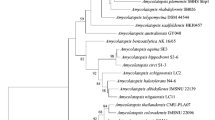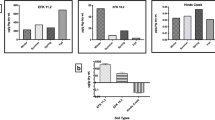Abstract
Preliminary studies of Pu(V) sorption to site-specific microorganisms isolated from the Triassic clay selected as an engineered barrier for the near surface low and intermediate level radioactive waste repository and from groundwater at the expected site were carried out. Adsorption of Pu(V) by bacteria attained the maxima values of 82–84 % at pH 6–7. The maximum adsorption values of Pu of about 100 % were found for Penicillium chrysogenum at pH 4.1. Bioreduction of Pu(V) to Pu(IV) by Bacillus cereus was observed, while any Pu(III) was not found in the system.






Similar content being viewed by others
References
Newsome L, Morris K, Lloyd JR (2014) The biogeochemistry and bioremediation of uranium and other priority radionuclides. Chem Geol 363:164–184
Lloyd JR (2003) Microbial reduction of metals and radionuclides. FEMS Microbiol Rev 27:411–425
Brookshaw DR, Pattrick RAD, Lloyd JR, Vaughan DJ (2012) Microbial effects on mineral radionuclide interactions and radionuclide solid-phase capture processes. Mineral Mag 76(3):777–806
Prakash D, Gabani P, Chandel AK, Ronen Z, Singh OV (2013) Bioremediation: a genuine technology to remediate radionuclides from the environment. Microb Biotechnol 6(4):349–360
Li X, Ding C, Liao J, Lan T, Li F, Zhang D, Yang J, Yang Y, Luo S, Tang J, Li N (2014) Biosorption of uranium on Bacillus sp. dwc-2: preliminary investigation on mechanism. J Environ Radioact 135:6–12
Francis AJ (2015) Microbes affect the speciation of various uranium compounds in wastes and soils. In: Merkel BJ, Arab A (eds) Uranium-past and future challenges. Springer, Switzerland
Hirose K, Tanoue E (2001) Strong ligands for thorium complexation in marine bacteria. Mar Environ Res 51:95–112
Rusin PA, Quintana L, Brainard JR, Strietelmeier BA, Tait CD, Ekberg SA, Palmer PD, Newton TW, Clark DL (1991) Solubilization of plutonium hydrous oxide by iron-reducing bacteria. Environ Sci Technol 28:1686–1690
Boukhalfa H, Icopini GA, Reilly SD, Neu MP (2007) Plutonium(IV) reduction by the metal-reducing bacteria Geobacter metallireducens GS15 and Shewanella oneidensis MR1. Appl Environ Microbiol 73:5897–5903
Icopini GA, Lack JG, Hersman LE, Neu MP, Boukhalfa H (2009) Plutonium(V/VI) reduction by the metal-reducing bacteria Geobacter metallireducens GS-15 and Shewanella oneidensis MR-1. Appl Environ Microbiol 75(11):3641–3647
Renshaw JC, Law N, Geissler A, Livens FR, Lloyd JR (2009) Impact of the Fe(III)-reducing bacteria Geobacter sulfurreducens and Shewanella oneidensis on the speciation of plutonium. Biogeochemistry 94:191–196
Francis AJ, Dodge CJ, Gillow JB (2008) Reductive dissolution of Pu(IV) by Clostridium sp. under anaerobic conditions. Environ Sci Technol 42:2355–2360
Deo RP, Rittmann BE, Reed DT (2011) Bacterial Pu(V) reduction in the absence and presence of Fe(III)–NTA: modeling and experimental approach. Biodegradation 22:921–929
Reed DT, Pepper SE, Richmann MK, Smith G, Deo R, Rittmann BE (2007) Subsurface bio-mediated reduction of higher-valent uranium and plutonium. J Alloys Compd 444–445:376–382
Ohnuki T, Kozai N, Sakamoto F, Ozaki T, Nankawa T, Suzuki Y, Francis AJ (2010) Association of actinides with microorganisms and clay: implications for radionuclide migration from waste-repository sites. Geomicrobiol J 27:225–230
Lujanienė G, Šapolaitė J, Amulevičius AS, Mažeika K, Motiejūnas S (2006) Retention of cesium, plutonium and americium by engineered and natural barriers. Czechoslov J Phys 56(4):103–110
Lujanienė G, Šapolaitė J, Radžiūtė E, Aninkevičius V (2009) Plutonium oxidation state distribution in natural clay and goethite. J Radioanal Nucl Chem 282:793–797
Lujanienė G, Beneš P, Štamberg K, Ščiglo T (2012) Kinetics of plutonium and americium sorption to natural clay. J Environ Radioact 108:41–49
Lujanienė G, Štamberg K, Pakštas V, Juškėnas R, Kulakauskaitė I, Šemčuk S, Mažeika K, Vopalka D (2015) Study of Pu sorption behavior in natural clay. J Radioanal Nucl Chem 304:53–59
Hongoh Y, Ohkuma M, Kudo T (2003) Molecular analysis of bacterial microbiota in the gut of the termite Reticulitermes speratus (Isoptera; Rhinotermitidae). FEMS Microbiol Ecol 44(2):231–242
Marchesi JR, Sato T, Weightman AJ, Martin TA, Fry JC, Hiom SJ, Wade WG (1998) Design and evaluation of useful bacterium-specific PCR primers that amplify genes coding for bacterial 16S rRNA. Appl Environ Microbiol 64:795–799
Pitt JI (1979) The genus Penicillium and its teleomorphic states Eupenicillium and Talaromyces. Academic Press, London
Domsch KH, Gams W, Anderson TH (1980) Compendium of soil fungi, vol 1. Academic Press, London
Samson A, Frisvad JC (2004) Penicillium subgenus Penicillium: new taxonomic schemes and mycotoxins and other extrolites. Stud Mycol 49:1–257
Bertrand PA, Choppin GR (1982) Separation of actinides in different oxidation states by solvent extraction. Radiochim Acta 31:135–137
Andre C, Choppin GR (2000) Reduction of Pu(V) by humic acid. Radiochim Acta 88:613–616
Morgenstern A, Choppin GR (2002) Kinetics of the oxidation of Pu(IV) by manganese dioxide. Radiochim Acta 90(69–79):33
Xia Y, Rao L, Rai D, Felmy AR (2001) Determining the distribution of Pu, Np and U oxidation states in diluted NaCl and synthetic brine solutions. J Radioanal Nucl Chem 250:27–37
Nitsche H, Roberts K, Xi R, Prussian T, Becraft K, Al Mahsamid L, Silber HB, Carpenter SA, Gatti RC (1994) Long term plutonium solubility and speciation studies in a synthetic brine. Radiochim Acta 66(67):3–8
Lujanienė G (2011) Determination of Pu, Am and Cm in environmental samples. In: Proceeding international symposium on isotopes in hydrology, marine ecosystems, and climate change studies, Monaco, 27 Mar–1 Apr 2011, IAEA, Vienna, pp 411–418
Ticknor LO, Kolsto AB, Hill KK, Keim P, Laker MT, Tonks M, Jackson PJ (2001) Fluorescent amplified fragment length polymorphism analysis of Norwegian Bacillus cereus and Bacillus thuringiensis soil isolates. Appl Environ Microbiol 67(10):4863–4873
Candelon B, Guilloux K, Ehrlich SD, Sorokin A (2004) Two distinct types of rRNA operons in the Bacillus cereus group. Microbiology 150:601–611. doi:10.1099/mic.0.26870-0
Mandic-Mulec I, Prosser JI (2011) Diversity of endospore-forming bacteria in soil: characterization and driving mechanisms. In: Logan NA, de Vos P (eds) Endospore-forming soil bacteria. Soil biology. Springer, Berlin. doi:10.1007/978-3-642-19577-8_2
Dhakar K, Sharma A, Pandey A (2014) Cold, pH and salt tolerant Penicillium spp. inhabit the high altitude soils in Himalaya, India. World J Microbiol Biotechnol 30(4):1315–1324
Lemire RJ, Fuger J, Nitsche H, Potter P, Rand MH, Rydberg J, Spahiuk J, Sullivan C, Ullman WJ, Vitorge P, Wanner H (2001) Chemical thermodynamics of neptunium and plutonium, vol 4. Elsevier, Paris
Choppin GR (2007) Actinide speciation in the environment. J Radioanal Nucl Chem 273:695–703
Saleem M, Ahmad S, Ahmad M (2014) Potential of Bacillus cereus for bioremediation of pulp and paper industrial waste. Ann Microbiol 64:823–829
Rohini B, Jayalakshmi S (2015) Bioremediation potential of Bacillus cereus against copper and other heavy metals. Int J Adv Res Biol Sci 2:200
Shaw DR, Dussan J (2015) Mathematical modelling of toxic metal uptake and efflux pump in metal-resistant bacterium Bacillus cereus isolated from heavy crude oil. Water Air Soil Pollut 226:112
Pan J, Liu R, Tang H (2007) Surface reaction of Bacillus cereus biomass and its biosorption for lead and copper ions. J Environ Sci 19:403–440
Das S, Pandey S, Pradhan SK, Sudarshan M, Chakraborty A, Thatoi HN (2015) Genomic analysis and comparative hexavalent chromium reduction potential of predominant Bacillus species isolated from chromite mine soil. Soil Sediment Contam 24:206–221
Emadzadeha M, Pazoukib M, Abdollahzadeh Sharghib E, Taghavia L (2016) Experimental sudy on the factors affecting hexavalent chromium bioreduction by Bacillus cereus. Int J Eng Trans B 29(02):152–159
Tsezos M (2007) Biological removal of ions: principles and applications. Adv Mater Res 20–21:589–596
Lloyd JR, Renshaw JC (2005) Bioremediation of radioactive waste: radionuclide–microbe interactions in laboratory and field-scale studies. Curr Opin Biotechnol 16:254–260
Icopini GH, Boukhalfa H, Neu MP (2007) Biological reduction of Np(V) and Np(V) citrate by metal reducing bacteria. Environ Sci Technol 41:2764–2769
Bopp LH, Ehrlich HL (1988) Chromate resistance and reduction in Pseudomonas fluorescence strain LB300. Arch Microbiol 150:426–431
Wang PC, Mori T, Toda Ohtake (1990) Membrane-associated chromate reductase activity from Enterobacter cloacae. J Bacteriol 172:1670–1672
Park CH, Keyhan M, Wielinga B, Fendorf S, Matin A (2000) Purification to homogeneity and characterization of a novel Pseudomonas putida chromate reductase. Appl Environ Microbiol 66:1788–1795
Ackerley DF, Gonzalez CF, Park CH, Blake R, Keyhan M, Matin A (2004) Chromate reducing properties of soluble flavoproteins from Pseudomonas putida and Escherichia coli. Appl Environ Microbiol 70:873–882
Author information
Authors and Affiliations
Corresponding author
Rights and permissions
About this article
Cite this article
Lujanienė, G., Levinskaitė, L., Kačergius, A. et al. Sorption of plutonium to bacteria and fungi isolated from groundwater and clay samples. J Radioanal Nucl Chem 311, 1393–1399 (2017). https://doi.org/10.1007/s10967-016-5016-x
Received:
Published:
Issue Date:
DOI: https://doi.org/10.1007/s10967-016-5016-x




